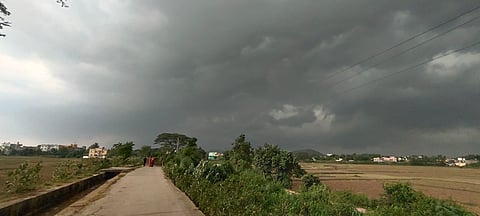

An eerie silence has pervaded the seaside villages of Kendrapara and Jagatsinghpur districts of Odisha on October 22, 2024 as Cyclone Dana is set to hit the coast on October 25, coinciding with the 25th anniversary of the devastating 1999 super cyclone, the most intense recorded tropical cyclone in the North Indian Ocean.
Dana is expected to make landfall near Bhitarkanika National Park in Rajnagar block, Kendrapara, which has prompted widespread panic among the coastal communities. The storm surge is predicted to be particularly dangerous, with the cyclone coinciding with high tides.
Coastal Odisha is no stranger to tropical cyclones, with many striking in October. On 29 October 1971, around 5,000 people lost their lives in a cyclone that flattened four villages under Satabhaya Gram Panchayat in Kendrapara. The super cyclone of 1999, which tore through Kendrapara and Jagatsinghpur, claimed approximately 10,000 lives. More recently, Cyclones Phailin (2013), Hudhud (2014) and Titli (2018) also struck Odisha during October.
The extreme sea surface temperatures in the Bay of Bengal after the monsoon withdrawal are a key factor in the intensity of cyclones at this time of year, according to Sarat Chandra Sahu, former Director of the Regional Meteorological Centre in Bhubaneswar.
“The location of the jet stream near the northern Himalayas creates favourable conditions for low to medium wind shear, aiding in the intensification of cyclones,” said Sahu. “Cyclones forming in October, after the monsoon, tend to be more severe due to the cooler air surrounding the cyclone’s eye.”
Tentulikandha village, situated just a kilometre from the Bay of Bengal in Mahakalapada block, Kendrapara, is a stark reminder of the 1999 tragedy. On October 29, 1999, the village suffered 28 human casualties.
Bharat Swain (55) lost his father, wife and daughter in the disaster. “October is supposed to be a festive season, but for us, it is a time of dread. Twenty-five years ago, our village became a mass grave. Now, we are bracing for Dana,” said Bharat, who, along with his fellow village residents, will seek refuge in the cyclone shelter built in 2021.
Reflecting on the past, Swain added, “We were responsible for the deaths of many village residents 25 years ago. We had denuded large tracts of mangrove forests, nature’s barrier against cyclones. We paid the price. Now, we have learnt to protect the mangroves and heed cyclone warnings.”
In neighbouring Jagatsinghpur district, similar fear grips the villages. “Although the sea frightens us, the super cyclone taught us to take these warnings seriously,” said Parikhita Mandal, a school teacher from Dahibar village under Earasama block in Jagatsinghpur, as he helped with evacuation efforts.
As Cyclone Dana approaches, many seaside villages have become ghost towns, with residents fleeing their homes and moving their livestock to safer areas.
“Twenty-five years ago, my life changed forever. I survived the super cyclone by sheltering in the only two-storey house in the village, but I lost two brothers,” recalled Mahadev Mandal of Musadiha village. “Today, our village has cyclone shelters, concrete roads and pucca houses. We have learnt to move towards safety.”
The fishing villages of Sandakuda, Balisahi, Ghanaghalia, Bijayachandapur, Musadiha and others near Paradip port were decimated by the 1999 super cyclone. “I lost my parents in the storm. Now we are ready to face Cyclone Dana,” said Umesh Rout (55) of Musadiha.
While the coastal areas have slowly rebuilt over the past 25 years, with livelihoods recovering and infrastructure improving, the looming threat of Cyclone Dana has reignited painful memories.
“The super cyclone of 1999 took hundreds of lives and forever changed the landscape of coastal Odisha. Now, as Cyclone Dana approaches, we can only hope that the lessons learned from the past will help us face this new danger,” said Biswanath Behera, a retired engineer from Kendrapara.